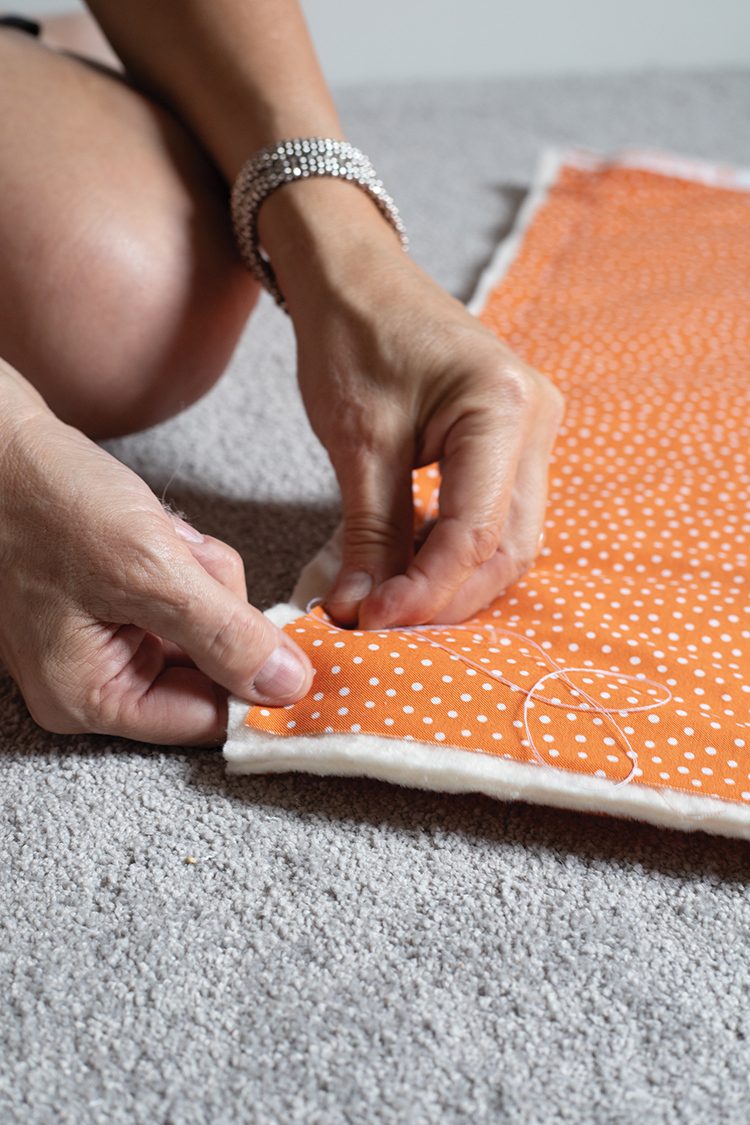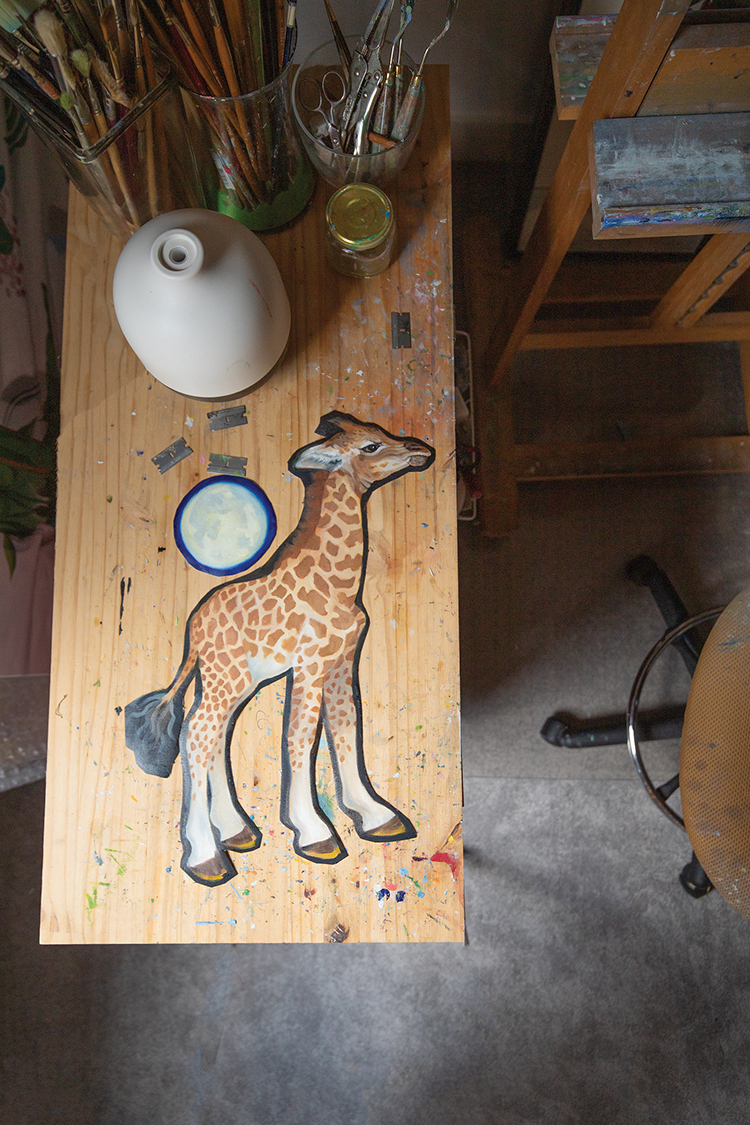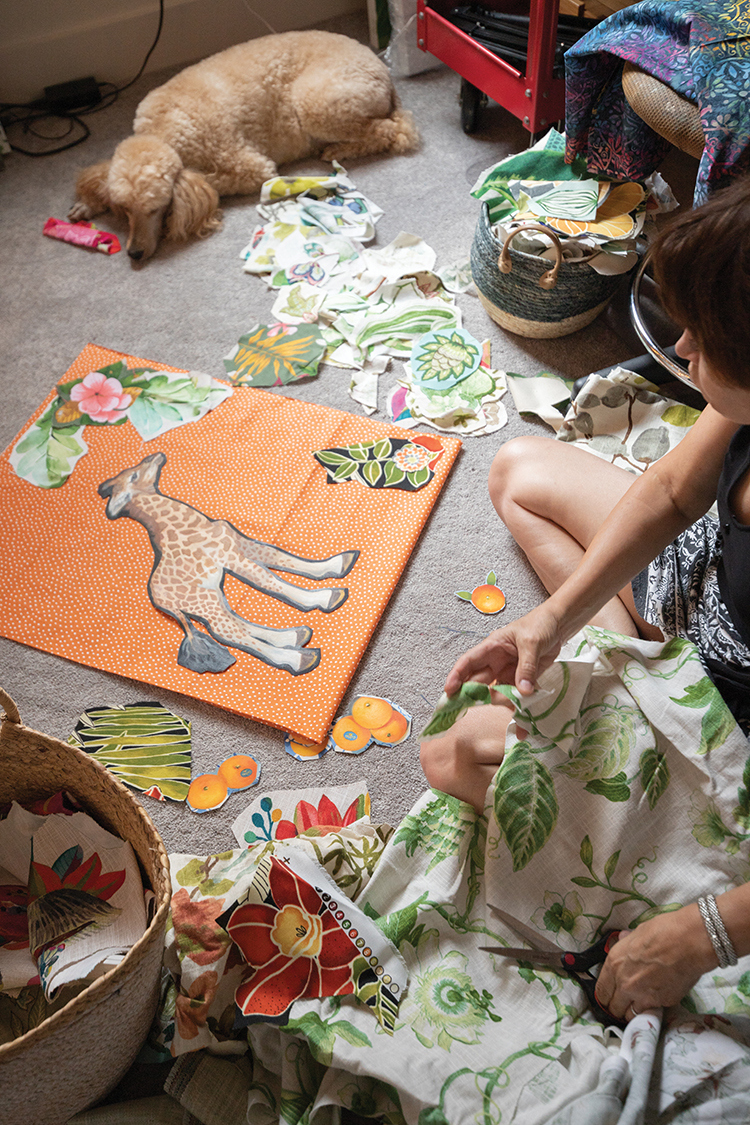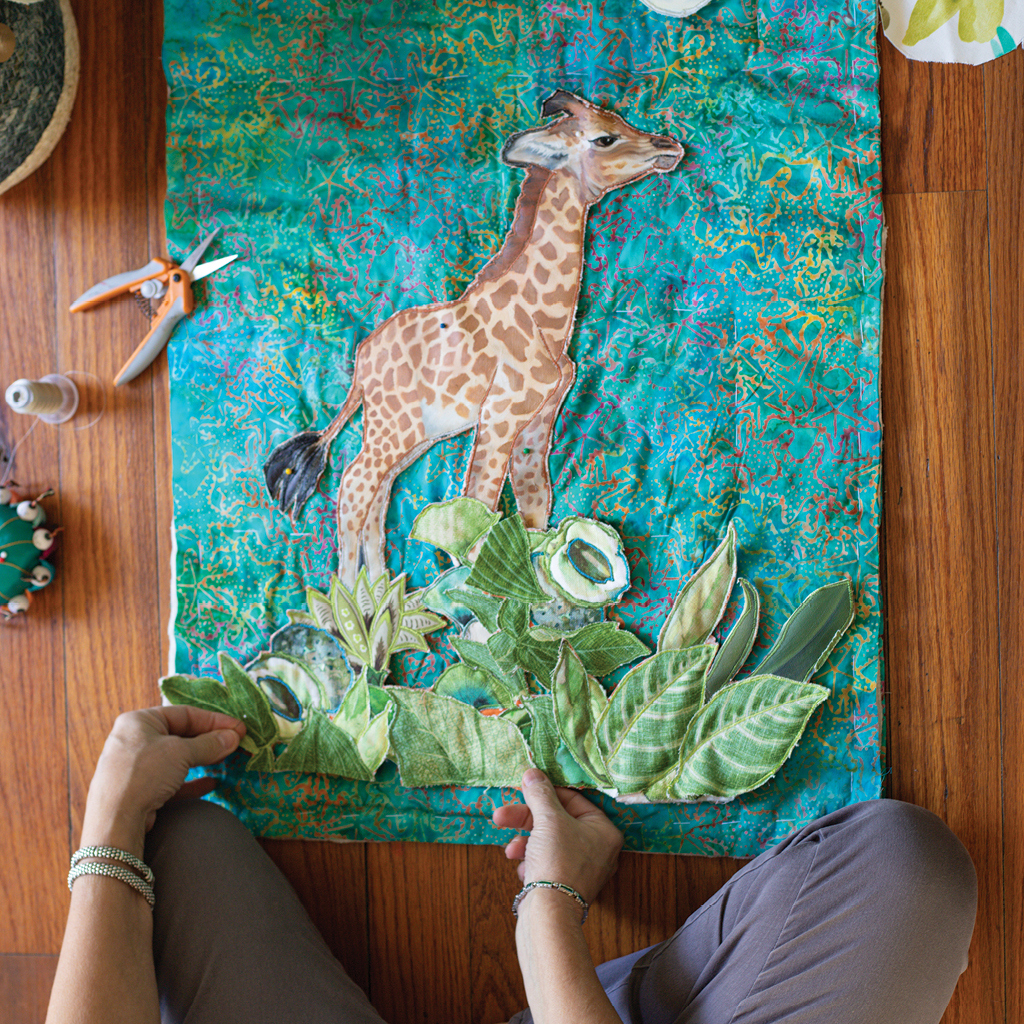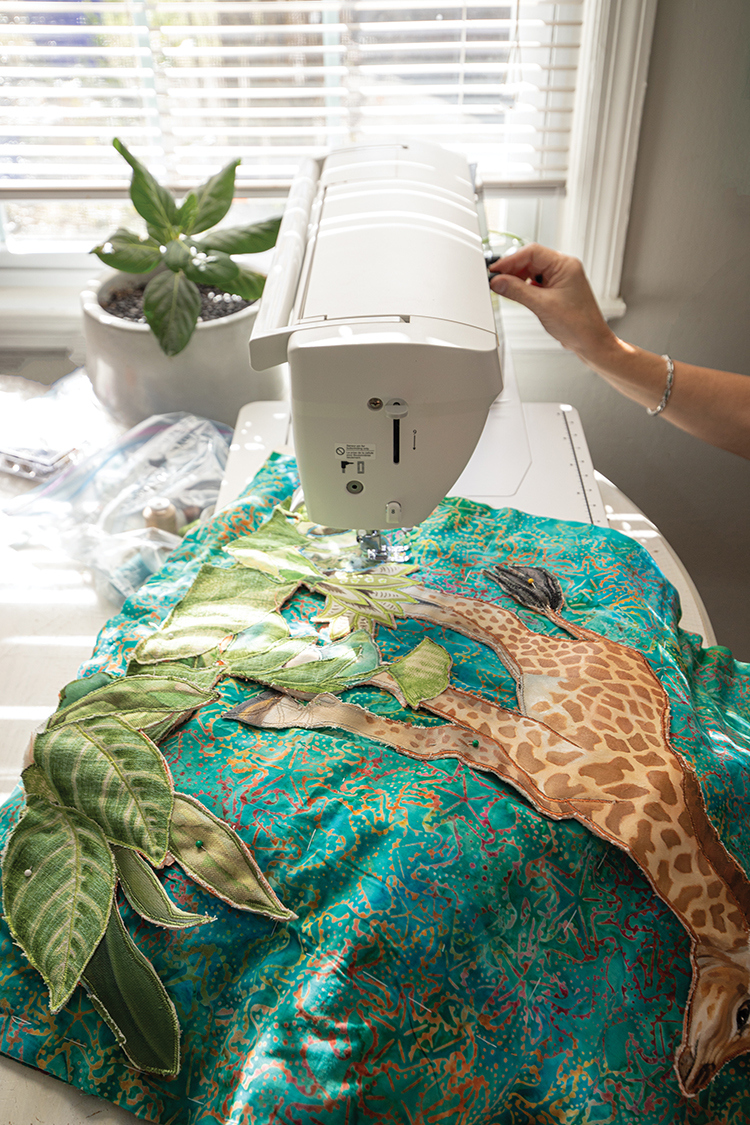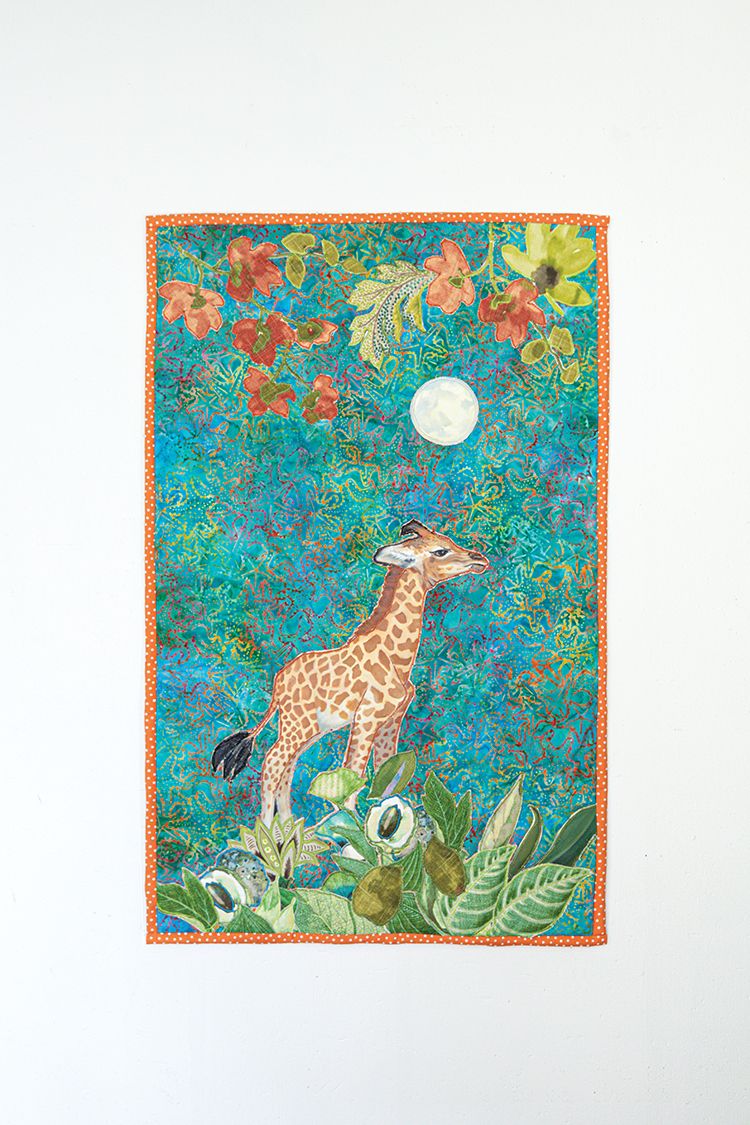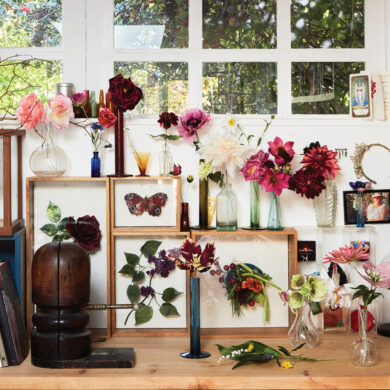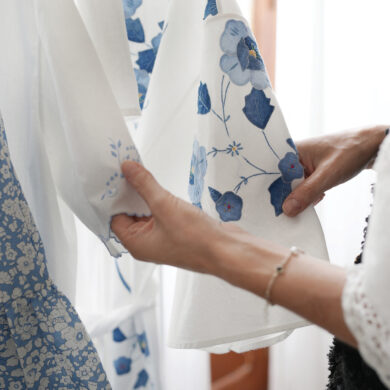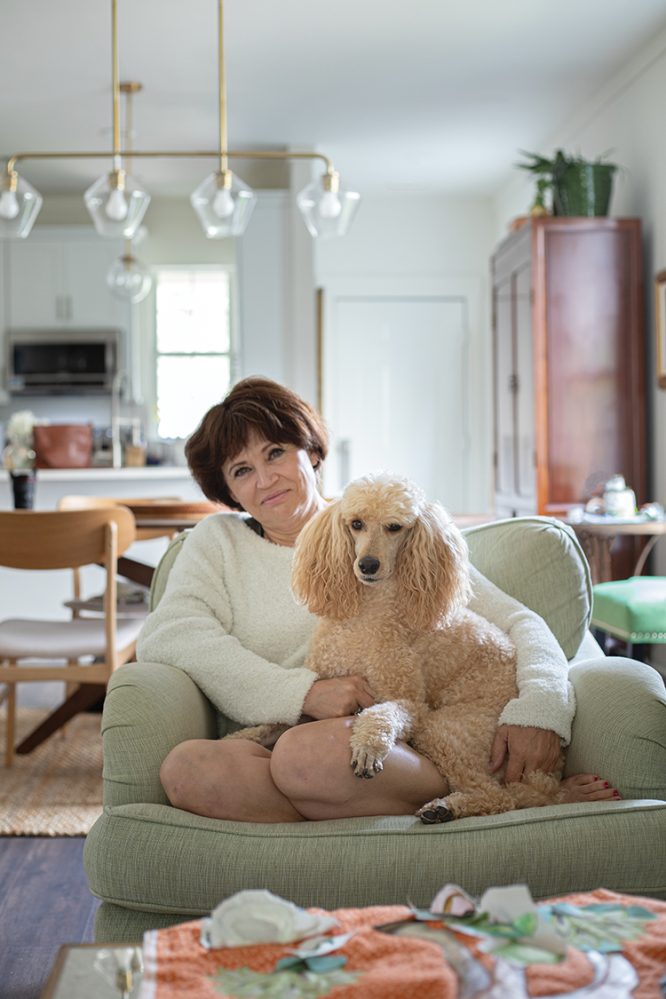
Journey
I have always been a creative. I am certain that I came out of my mother’s womb with a paintbrush in my tiny hand! As all creatives will understand, I am most at peace when I am creating. After high school, I enrolled as a student in the fine arts department of my local college. Unfortunately, like most artists, I was told that I would never make a living as an artist, so I reluctantly switched my major to English literature.
After the birth of my three perfect children, I returned to school for the second time and earned a degree in interior design. I worked in that field for several years while raising my family.
When I was in my mid-40s, with all children having left the nest, I had the opportunity to finally fulfill my lifelong dream of finishing my fine arts education with a degree in painting. I attended one of the most amazing fine art institutions in America today, the Savannah College of Art and Design (I might be biased), which, fortunately for me, was close to home. My education there was a delight. I was the oddball old lady in each of my classes, but once the other students saw that I was serious about my work, they accepted me. I graduated in 2014 summa cum laude and have been working full time as an artist ever since.
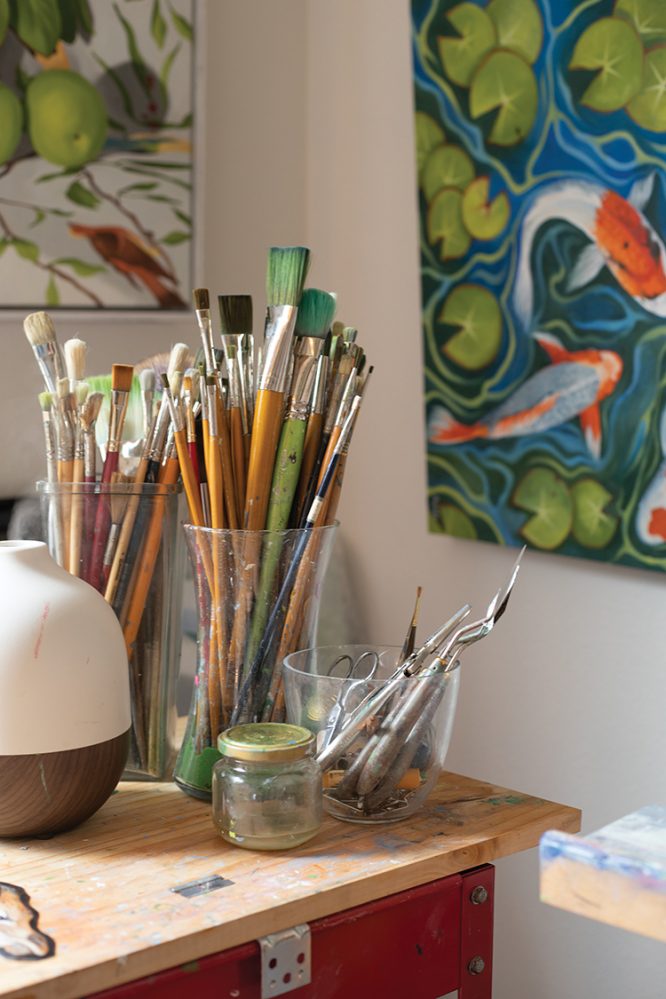
My art practice was for many years devoted to oil painting, and I became known for my still life pieces. Then the pandemic hit. Everything changed for every person, each in their own way. I was very sick in March of 2020, unable to get off my sofa for a couple of weeks. There were no tests for the virus at that time, so my doctor advised that I stay home and avoid contact with others. I was never so sick that I needed hospitalization, thankfully.
After the initial sickness, I was left with a deep lethargy and depression that felt overwhelming. I knew that I needed to get back to my art, as this has always been my greatest weapon against depression, but I had zero energy for sitting at my easel. So, I sat on the floor of my studio and decided to get rid of some of my “reject” paintings. There were sections of each painting that were excellent, that I really did not want to lose, so I cut those sections out. Eventually, I had a pile of beautiful images, but what was I to do with them?
Sewing is another of my passions, but I had put it aside to pursue my painting practice. Still, I collect fabric, some for my still life work and some for interior design projects. I thought it might be interesting to combine some of my fabric with the cutouts, so I spread a roll of fabric on my studio floor and placed some of the painted images on top. I played around with composition and then added some applique cutouts from other pieces of fabric. The result was fantastic! I knew immediately that I had stumbled onto something both original and beautiful! I couldn’t wait to put the vision I had into practice.
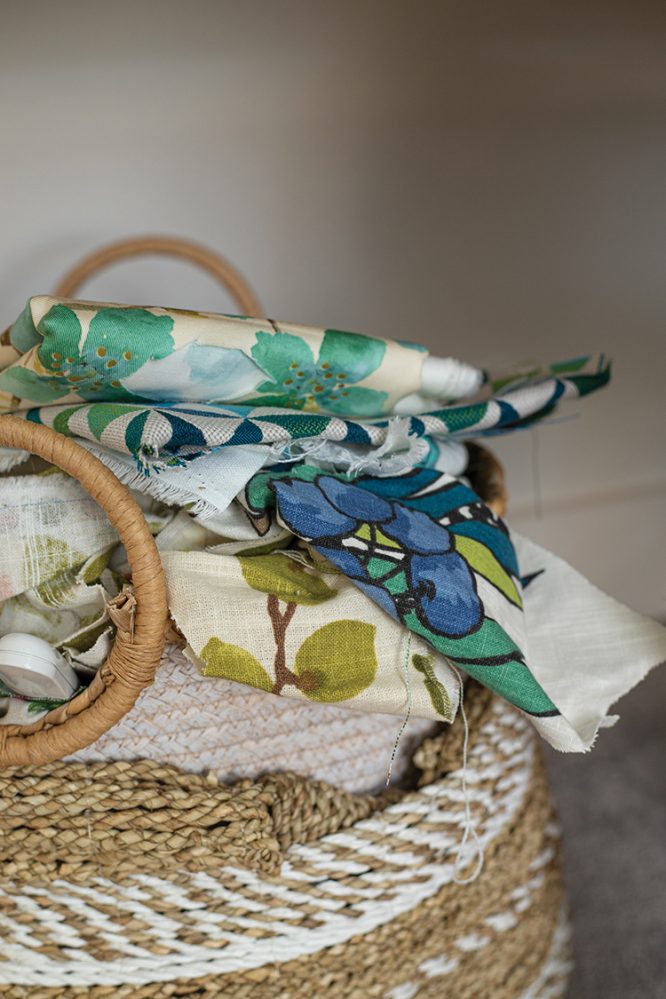
“Creativity takes courage.”
— HENRI MATISSE
Process
Each quilt begins as a vision in my mind. For some, I already have painted pieces that I want to use; for others, I paint the image(s) based on the idea I have. Either way, it is the painted canvas pieces that inspire the rest of the quilt.
I begin by placing a piece of calico fabric on the floor. I have predetermined the general size of the finished quilt based on the size of the image(s). I play around with composition, cutting out appliques from other fabrics, until I have the design exactly as I want it. Next, I take a photograph of the composition, so I will remember where each element belongs.
Now the quilting begins! I place batting between two identically sized pieces of calico fabric and cut it to the same size. Trimming of the edges comes later. Then, using a large sewing needle, I baste the three layers together. Now I can place the appliques and painted pieces back onto the fabric, according to my photograph. I do not add them back all at once but rather one piece at a time, which I sew onto the background fabric. I start with the images in the background and work forward, one applique at a time. Each applique is sewn around the edges only. This step is simply to adhere the image to the fabric.
Once the composition is complete, the fun begins! The most time-consuming part of the process involves quilting the appliques to the quilt with decorative thread. I may use up to dozens of different colors of thread on each quilt, according to the color of the image I am sewing. I enhance the shapes and curves of each applique, following the lines in the image itself. This involves sewing over various sections of each image, not simply the edges. I choose my colors to enhance the overall coloration of the quilt. This gives the finished piece its life.
Once this step is completed, I trim the edges of the quilt so that it is squared. I sew triangular pockets onto the top of the back of the quilt, where the dowel for hanging the piece will sit. Then I create a banding that will finish the edges nicely, attaching it on the front by machine and then rolling it and securing it by hand on the back of the quilt. Voila!
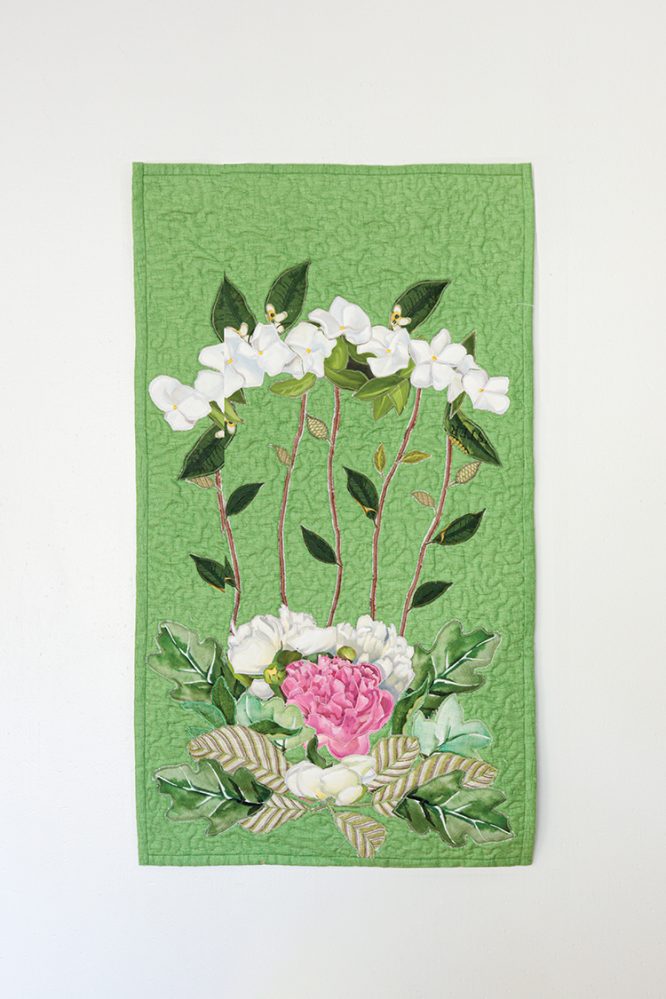
Challenges
I believe that every artist experiences many of the same challenges when it comes to their creative output: How do I make enough doing this to allow me to keep doing it? How do I make certain that my work is seen? How do I price my work so that people will purchase it but still cover my costs and labor? These are universal dilemmas that each of us must deal with.
My greatest challenge has certainly been economical. The quilts are labor intensive, involving so many more steps than traditional painting. The hours that go into the creation of a single quilt makes them relatively costly. I must devalue the cost of my labor in order to make them affordable. This is heart-wrenching for me.
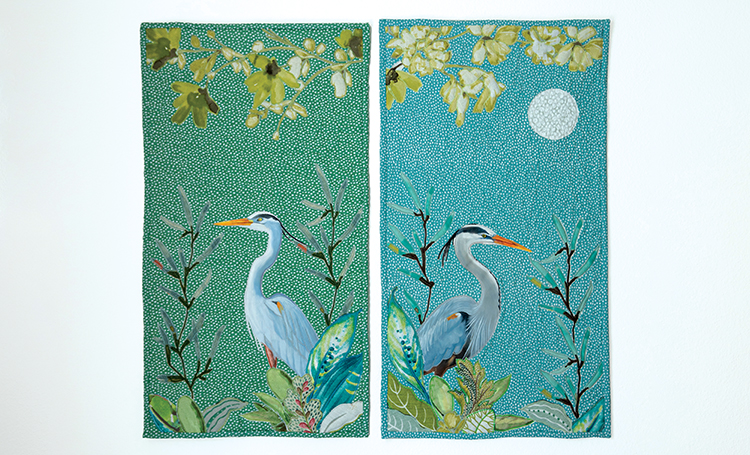
Another challenge is that my quilts are entirely unique. I have never seen anything like them. While this is wonderful, it also means that marketing the quilts is challenging. People are not certain of what they are seeing or the inherent value of the pieces.
The quilts, while two-dimensional, have a tactile quality that must be seen to be appreciated. Like a lot of mixed media, there is that extra layer of beauty not found in traditional 2D art. The quilts can be framed, or not, according to the desire of the owner. The framed quilts do take the finished piece to another level, however. I would like to have every finished quilt framed, but the cost is, at this time, prohibitive.
“The world always seems brighter when you’ve made something that wasn’t there before.”
— Neil Gaiman
My Studios
I recently moved, so my two studios are still in the process of evolving into what I will want and need. I have one studio for my painting process and a second for my sewing. I am constantly inspired and cheered by my art on the walls surrounding me. It is akin to living in a make believe world of color and texture.
In my sewing studio, open shelving is essential for easy access to materials used daily. Baskets hold my fabrics and the appliques that I have already cut out. My threads are at my side, displayed according to color, making it easier to select what I need. Scissors, pins and other small tools are on a pegboard at my side. I have everything arranged so that I can sit at my machine and not have to constantly stand to retrieve what I need.
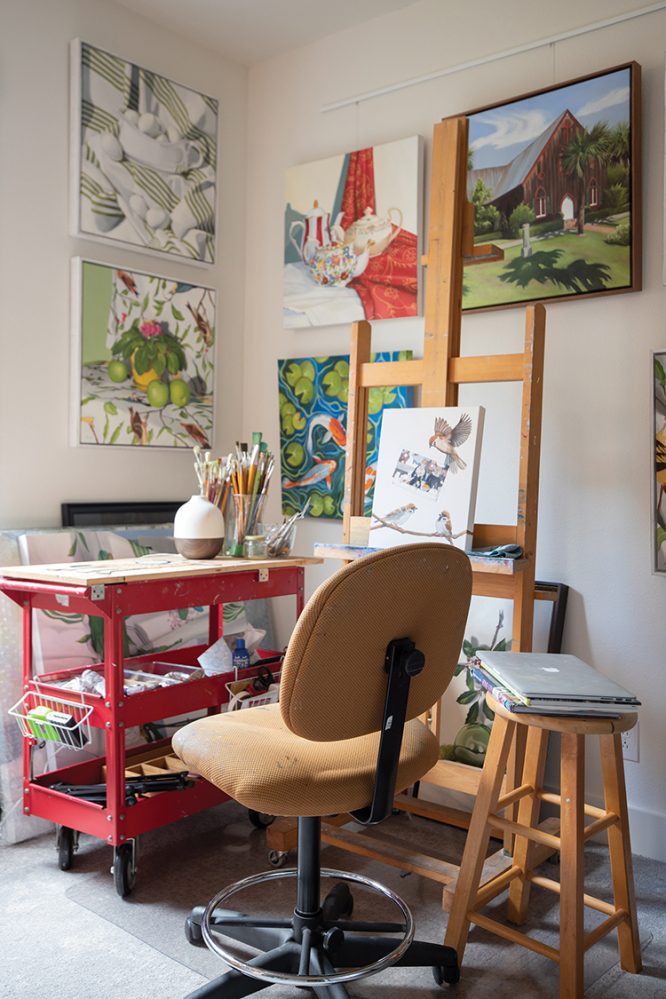
“Art is my life and my life is art.”
— YOKO ONO
Hannah
One of the great loves of my life is my poodle, Hannah. She is a 7-year-old apricot size-challenged standard of only 25 pounds. She is also my constant companion. When I am creating, she is usually on the floor or the bed behind me. During my battle with COVID, Hannah slept on the sofa beside me — she rarely left my side. She is a very smart, sensitive, kind soul in the body of a beautiful creature. I consider it a privilege to have her in my life. I just recently wrote and illustrated a children’s book about her, titled Hannah Banana’s Perfect Life, as a gift to my new grandson!
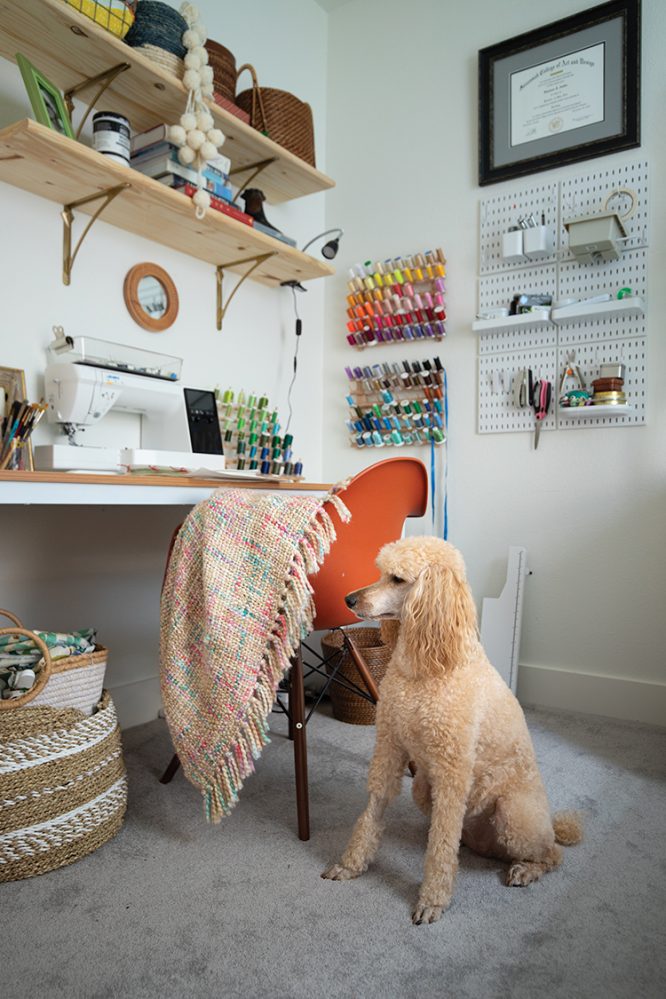

Journey
I have always been a creative. I am certain that I came out of my mother’s womb with a paintbrush in my tiny hand! As all creatives will understand, I am most at peace when I am creating. After high school, I enrolled as a student in the fine arts department of my local college. Unfortunately, like most artists, I was told that I would never make a living as an artist, so I reluctantly switched my major to English literature.
After the birth of my three perfect children, I returned to school for the second time and earned a degree in interior design. I worked in that field for several years while raising my family.
When I was in my mid-40s, with all children having left the nest, I had the opportunity to finally fulfill my lifelong dream of finishing my fine arts education with a degree in painting. I attended one of the most amazing fine art institutions in America today, the Savannah College of Art and Design (I might be biased), which, fortunately for me, was close to home. My education there was a delight. I was the oddball old lady in each of my classes, but once the other students saw that I was serious about my work, they accepted me. I graduated in 2014 summa cum laude and have been working full time as an artist ever since.

My art practice was for many years devoted to oil painting, and I became known for my still life pieces. Then the pandemic hit. Everything changed for every person, each in their own way. I was very sick in March of 2020, unable to get off my sofa for a couple of weeks. There were no tests for the virus at that time, so my doctor advised that I stay home and avoid contact with others. I was never so sick that I needed hospitalization, thankfully.
After the initial sickness, I was left with a deep lethargy and depression that felt overwhelming. I knew that I needed to get back to my art, as this has always been my greatest weapon against depression, but I had zero energy for sitting at my easel. So, I sat on the floor of my studio and decided to get rid of some of my “reject” paintings. There were sections of each painting that were excellent, that I really did not want to lose, so I cut those sections out. Eventually, I had a pile of beautiful images, but what was I to do with them?
Sewing is another of my passions, but I had put it aside to pursue my painting practice. Still, I collect fabric, some for my still life work and some for interior design projects. I thought it might be interesting to combine some of my fabric with the cutouts, so I spread a roll of fabric on my studio floor and placed some of the painted images on top. I played around with composition and then added some applique cutouts from other pieces of fabric. The result was fantastic! I knew immediately that I had stumbled onto something both original and beautiful! I couldn’t wait to put the vision I had into practice.

“Creativity takes courage.”
— HENRI MATISSE
Process
Each quilt begins as a vision in my mind. For some, I already have painted pieces that I want to use; for others, I paint the image(s) based on the idea I have. Either way, it is the painted canvas pieces that inspire the rest of the quilt.
I begin by placing a piece of calico fabric on the floor. I have predetermined the general size of the finished quilt based on the size of the image(s). I play around with composition, cutting out appliques from other fabrics, until I have the design exactly as I want it. Next, I take a photograph of the composition, so I will remember where each element belongs.
Now the quilting begins! I place batting between two identically sized pieces of calico fabric and cut it to the same size. Trimming of the edges comes later. Then, using a large sewing needle, I baste the three layers together. Now I can place the appliques and painted pieces back onto the fabric, according to my photograph. I do not add them back all at once but rather one piece at a time, which I sew onto the background fabric. I start with the images in the background and work forward, one applique at a time. Each applique is sewn around the edges only. This step is simply to adhere the image to the fabric.
Once the composition is complete, the fun begins! The most time-consuming part of the process involves quilting the appliques to the quilt with decorative thread. I may use up to dozens of different colors of thread on each quilt, according to the color of the image I am sewing. I enhance the shapes and curves of each applique, following the lines in the image itself. This involves sewing over various sections of each image, not simply the edges. I choose my colors to enhance the overall coloration of the quilt. This gives the finished piece its life.
Once this step is completed, I trim the edges of the quilt so that it is squared. I sew triangular pockets onto the top of the back of the quilt, where the dowel for hanging the piece will sit. Then I create a banding that will finish the edges nicely, attaching it on the front by machine and then rolling it and securing it by hand on the back of the quilt. Voila!

Challenges
I believe that every artist experiences many of the same challenges when it comes to their creative output: How do I make enough doing this to allow me to keep doing it? How do I make certain that my work is seen? How do I price my work so that people will purchase it but still cover my costs and labor? These are universal dilemmas that each of us must deal with.
My greatest challenge has certainly been economical. The quilts are labor intensive, involving so many more steps than traditional painting. The hours that go into the creation of a single quilt makes them relatively costly. I must devalue the cost of my labor in order to make them affordable. This is heart-wrenching for me.

Another challenge is that my quilts are entirely unique. I have never seen anything like them. While this is wonderful, it also means that marketing the quilts is challenging. People are not certain of what they are seeing or the inherent value of the pieces.
The quilts, while two-dimensional, have a tactile quality that must be seen to be appreciated. Like a lot of mixed media, there is that extra layer of beauty not found in traditional 2D art. The quilts can be framed, or not, according to the desire of the owner. The framed quilts do take the finished piece to another level, however. I would like to have every finished quilt framed, but the cost is, at this time, prohibitive.
“The world always seems brighter when you’ve made something that wasn’t there before.”
— Neil Gaiman
My Studios
I recently moved, so my two studios are still in the process of evolving into what I will want and need. I have one studio for my painting process and a second for my sewing. I am constantly inspired and cheered by my art on the walls surrounding me. It is akin to living in a make believe world of color and texture.
In my sewing studio, open shelving is essential for easy access to materials used daily. Baskets hold my fabrics and the appliques that I have already cut out. My threads are at my side, displayed according to color, making it easier to select what I need. Scissors, pins and other small tools are on a pegboard at my side. I have everything arranged so that I can sit at my machine and not have to constantly stand to retrieve what I need.

“Art is my life and my life is art.”
— YOKO ONO
Hannah
One of the great loves of my life is my poodle, Hannah. She is a 7-year-old apricot size-challenged standard of only 25 pounds. She is also my constant companion. When I am creating, she is usually on the floor or the bed behind me. During my battle with COVID, Hannah slept on the sofa beside me — she rarely left my side. She is a very smart, sensitive, kind soul in the body of a beautiful creature. I consider it a privilege to have her in my life. I just recently wrote and illustrated a children’s book about her, titled Hannah Banana’s Perfect Life, as a gift to my new grandson!









